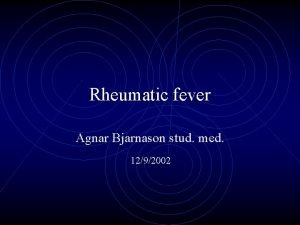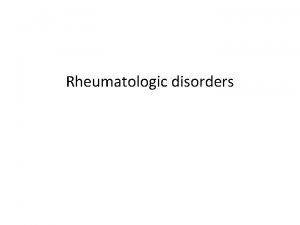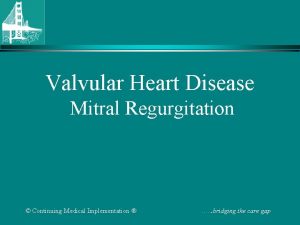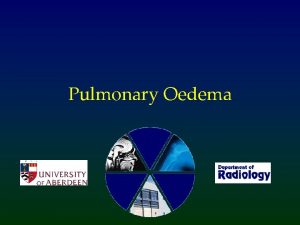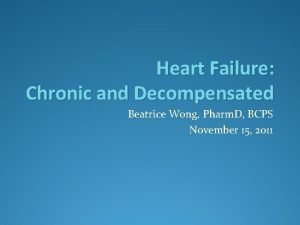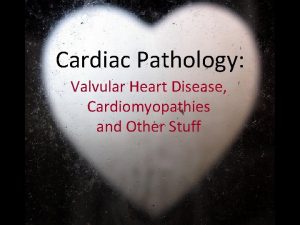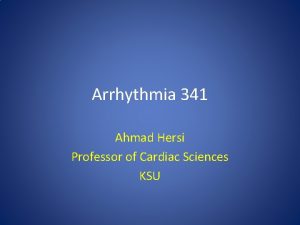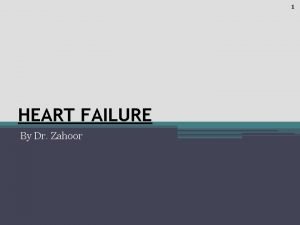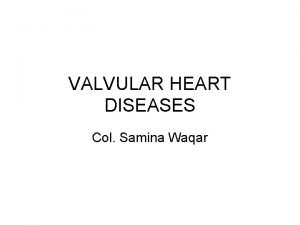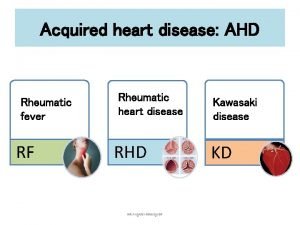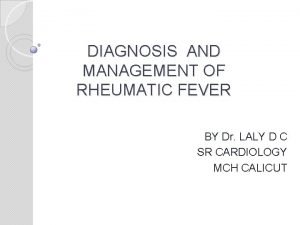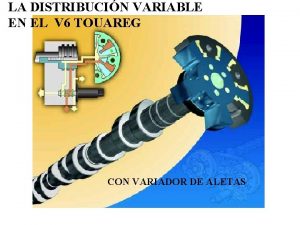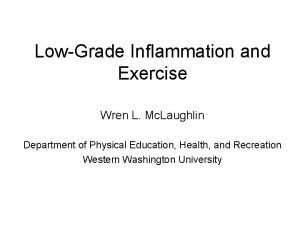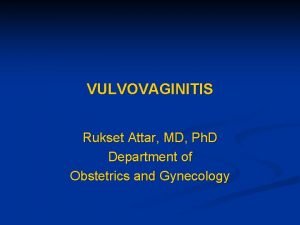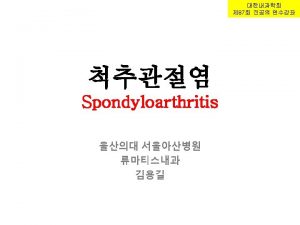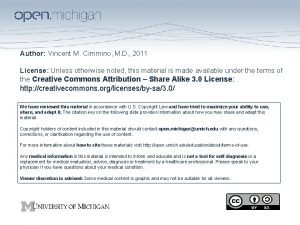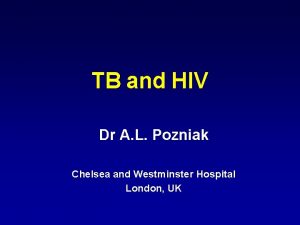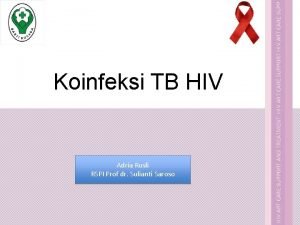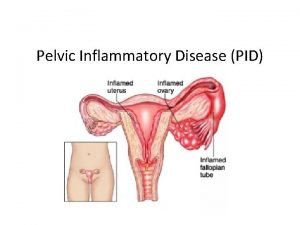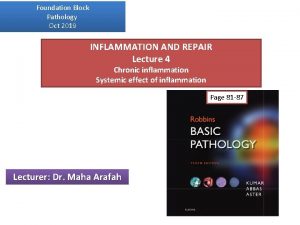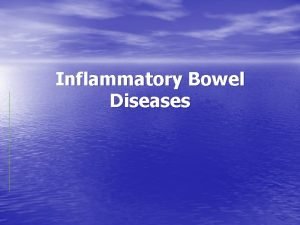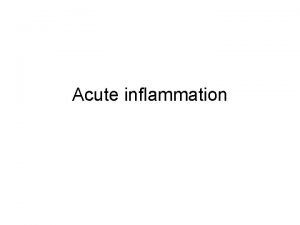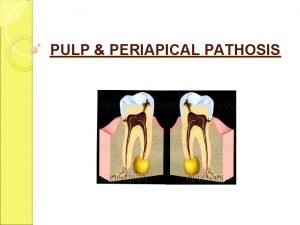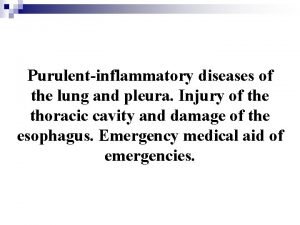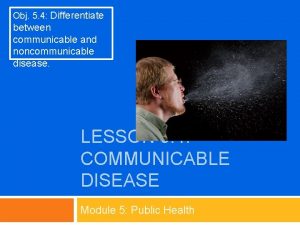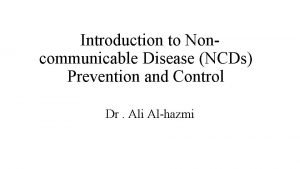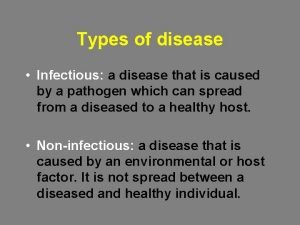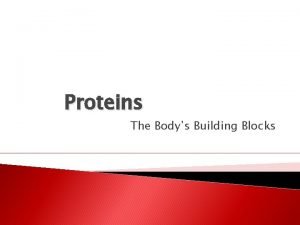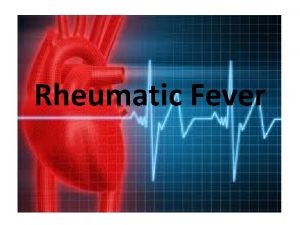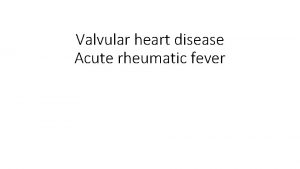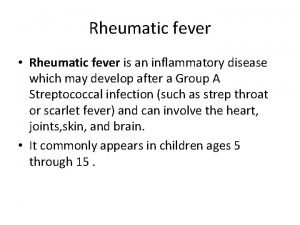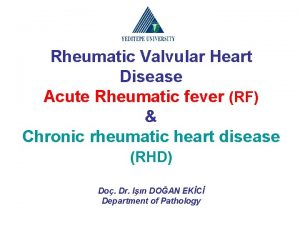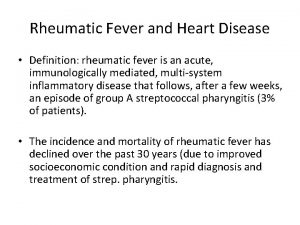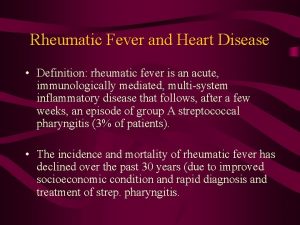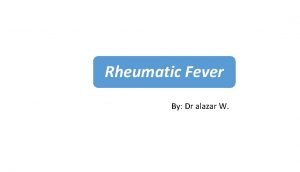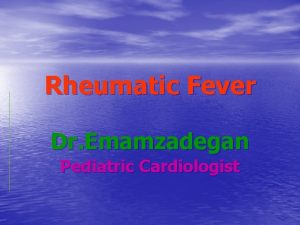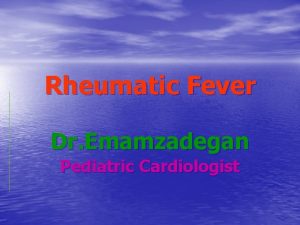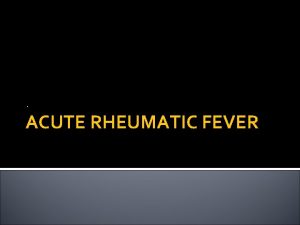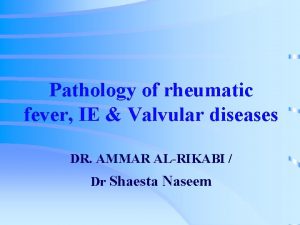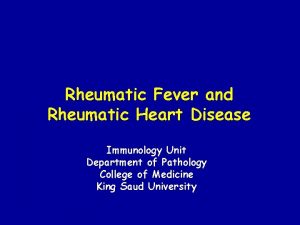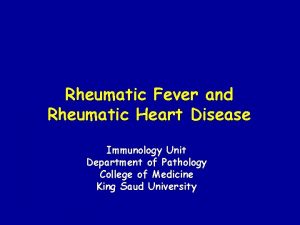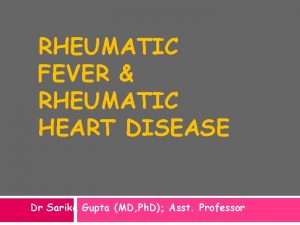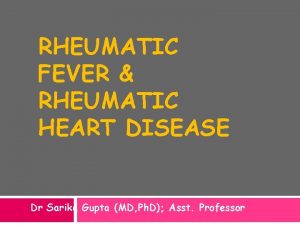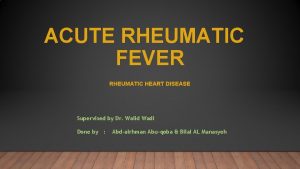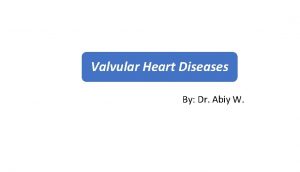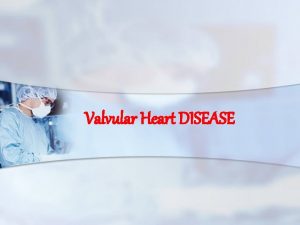Inflammatory and Valvular Heart Diseases Rheumatic Fever and






























































- Slides: 62

Inflammatory and Valvular Heart Diseases

Rheumatic Fever and Heart Disease • Rheumatic Fever - inflammatory disease of heart potentially involving all layers • Systemic • Abnormal immune response to group A beta hemolytic strep (“strep throat”) • Transmission to heart via lymphatic channels Most common cause of valvular heart disease

Rheumatic Fever and Heart Disease • Rheumatic Heart Disease – chronic condition characterized by scarring and deformity of heart valves resulting from rheumatic fever • Any or all layers of heart maybe affected

Rheumatic Fever and Heart Disease • Rheumatic endocarditis (most serious) • Erosion and swelling of valves (thickening) • Vegetations • Stenosis/Regurgitation • Rheumatic Myocarditis • Nodules and fibrin deposits loss of contractile power CHF • Rheumatic Pericarditis • Fibrinous Exudate and pericardial effusion

Rheumatic Fever and Heart Disease • Nursing Assessment • • Previous history of rheumatic fever Socioeconomic class Fever Cardiovascular (tachycardia; pericardial friction rub; distant heart sounds; murmurs) • Neurological: chorea • Skin: subcutaneous nodules and erythema marginatum • Musculoskeletal: Polyarthritis

Rheumatic Fever and Heart Disease • Primary Prevention • Detection and treatment of strep throat • Secondary Prevention • Prophylactic antibiotics to prevent recurrent ARF

Rheumatic Fever and Heart Disease v v Acute Intervention Antibiotics Rest Control Fever Anti-Inflammatories

Infective Endocarditis • Infection of the inner layer (endocardium) of the heart that usually affects the cardiac valves • Was almost always fatal until development of penicillin • 5, 000 -8, 000 cases diagnosed in U. S. each year

Classification • Subacute form • • • Longer clinical course Insidious onset Streptococcus bovis or viridians Staphylococcus epidermidis HACEK group

Classification • Acute form • Shorter clinical course • Rapid onset • Causative organism more virulent • Streptococcus pneumoniae • Staphylococcus aureus • Streptococcus groups A, B, C • Fungi

Etiology and Pathophysiology • Vegetations • Fibrin, leukocytes, and microbes • Adhere to the valve or endocardium • Embolization of portions of vegetations into circulation

Bacterial Endocarditis of the Mitral Valve Fig. 36 -2

Etiology and Pathophysiology • Left-sided more common with bacterial infections and underlying heart disease • Right-sided lesions usually caused by IV drug abuse

Etiology and Pathophysiology • Risk Factors: • Cardiac Conditions (blood flow turbulence allows pathogen to infect previously damaged valves or other surfaces) • Rheumatic heart disease • Prosthetic valves • Aging • IV drug abuse • Invasive Medical and Dental Procedures • UTI, skin/wound infections

Clinical Manifestations • • • Nonspecific Fever occurs in 90% of patients Chills Weakness Malaise, Fatigue Anorexia

Clinical Manifestations • Vascular manifestations • • Splinter hemorrhages in nail beds Petechiae Osler’s nodes on fingers or toes Janeway’s lesions on palms or soles

Clinical Manifestations

Clinical Manifestations • Murmur in 80% of cases • CHF • in up to 80% with aortic valve endocarditis • 50% with mitral valve endocarditis • Manifestations secondary to embolism

Sites of Embolization

HISTORY • Recent dental, urologic, surgical, or gynecologic procedures • Heart disease • Recent cardiac catheterization • Skin, respiratory, or urinary tract infections

Diagnostic Studies • Labs • Blood cultures • Echocardiography (detects valvular vegetations, abscesses) • Chest x-ray

Collaborative Care • Prophylactic treatment for patients having: • Removal of drainage of infected tissue • Indwelling pacemakers • Renal dialysis • Ventriculoatrial shunts

Collaborative Care • Antibiotic administration • Monitor antibiotic serum levels • Antipyretics • Subsequent blood cultures • REST • Valve repair/replacement

Nursing Assessment • Subjective • History of valvular, congenital, or syphilitic cardiac diseases • Previous endocarditis • Staph or strep infection • Immunosuppressive therapy

Nursing Assessment • Recent surgical procedures or invasive procedures • IV drug abuse • Weight changes • Chills • Diaphoresis

Nursing Assessment • • Bloody urine Exercise intolerance Generalized weakness Fatigue Cough Dyspnea on exertion Night sweats Chest, back, abdominal pain

Nursing Assessment • Objective • • • Olser’s nodes Splinter hemorrhages Janeway’s lesions Petechiae Clubbing

Nursing Assessment • • Tachypnea Crackles Arrhythmias Leukocytosis Increased ESR and cardiac enzymes Positive cultures ECG showing chamber enlargement

Nursing Diagnoses v. Decreased cardiac output v. Activity intolerance v. Ineffective health maintenance

Acute Pericarditis • • Caused by inflammation of pericardial sac Etiologies: Infectious vs Non-Infectious S&S: dyspnea, CP, pericardial friction rub Complications • Pericardial effusion • Cardiac tamponade • Treatment • • • Antibiotics NSAIDS Corticosteroids Positioning head at 45 degree angle Pericardiocentesis

Valvular Heart Disease

Valvular Heart Disease • Heart contains two atrioventricular valves and two semilunar valves

Valvular Heart Disease • Types of valvular heart disease depends on: • Valve or valves affected • Two types of functional alterations • Stenosis • Regurgitation

Valvular Heart Disease • Stenosis • • Valve orifice is restricted Impending forward blood flow Creates a pressure gradient across open valve Degree of stenosis reflected in pressure gradient differences • Regurgitation • • Incomplete closure of valve leaflets Results in backward flow of blood

Mitral Valve Stenosis • Due to rheumatic heart disease • Causes scarring of valve leaflets and chordae tendineae • Contractures develop with adhesions between commissures of the leaflets • Stenotic mitral valve assumes funnel shape due to thickening and shortening of valve structures

Mitral Valve Stenosis • Pathophysiology: • Incomplete emptying of LA Increased LA pressure LA dilatation and hypertrophy • Increased LA pressure Elevated pulmonary pressure pulmonary congestion • Incomplete emptying of LA insufficient volumes to ventricles decreased C. O. • Afib is common risk of embolism

Clinical Manifestations • Dyspnea • Occasionally accompanied by hemoptysis • Primary symptom because of reduced lung compliance • • Palpitations from atrial fibrillation Fatigue Opening snap Low-pitched rumbling diastolic murmur Chest pain Seizures (from emboli) Stroke • Emboli can arise from stagnant blood in left atrium

Mitral Valve Regurgitation • Mitral Valve fails to close properly • LV ejects blood into aorta and back into LA

Mitral Valve Regurgitation • Majority of cases attributed to: • MI (MI with left ventricular failure places patient at risk for rupture of chordae tendineae) • Chronic rheumatic heart disease • Isolated rupture of chordae tendineae • Mitral valve prolapse • Ischemic papillary muscle dysfunction • Infectious endocarditis

Mitral Valve Regurgitation • Acute Onset (e. g. papillary dysfunction due to M. I. ) • Backward flow increased LA pressure Increased Pulmonary Pressure Pulmonary Edema • Chronic Onset • Backward flow LA dilates and hypertrophies Increased pulmonary pressures pulmonary congestion right sided failure

Mitral Valve Regurgitation Clinical Manifestations • Asymptomatic for years until development of some degree of left ventricular failure • Initial symptoms include: • Weakness • Fatigue • Dyspnea that gradually progress to orthopnea, paroxysmal nocturnal dyspnea, and peripheral edema

Aortic Valve Stenosis • Usually discovered in childhood, adolescence, or young adulthood • Those seen later in life usually have aortic stenosis from rheumatic fever or senile fibrocalcific degeneration of a normal valve

Aortic Valve Stenosis • Results in obstruction of flow from LV to aorta during systole • Effect is left ventricular hypertrophy and increased myocardial oxygen consumption because of increased myocardial mass • Leads to reduced CO and pulmonary hypertension

Aortic Valve Stenosis Clinical Manifestations • Symptoms of angina pectoris • Syncope • Heart failure • Occurs when valve orifice is 1/3 normal size

Aortic Valve Stenosis • Poor prognosis when experiencing symptoms and valve obstruction is not relieved • Why would Nitroglycerine be contraindicated with aortic valve stenosis?

Aortic Valve Regurgitation • May result from disease of aortic valve leaflets, aortic root, or both • Caused by: • Bacterial endocarditis • Trauma • Aortic dissection • Constitutes life-threatening emergency • Chronic aortic regurgitation results from: • • Rheumatic heart disease Congenital bicuspid aortic valve Syphilis Chronic rheumatic heart conditions

Aortic Valve Regurgitation • Physiologic consequence: • Retrograde blood flow from ascending aorta to left ventricle • Elevated LV pressures • LV dilatation and hypertrophy • Results in volume overload

Tricuspid Valve Disease • Tricuspid valve stenosis • Seen in IV drug users • Right atrial output is obstructed • Results in right atrial enlargement and elevated systemic venous pressure

Tricuspid Valve Disease Clinical Manifestations • • Peripheral edema Ascites Hepatomegaly Murmur

Collaborative Care • Drug therapy • Digitalis • Diuretics • Antiarrhythmics • b-blockers • Anticoagulants • Low-sodium diet

Collaborative Care • Percutaneous transluminal balloon valvuloplasty to split open fused commissures • Surgical therapy for valve repair • Annuloplasty • Valvuloplasty • Commissurotomy • Valve Replacement • Mechanical Vs. Biological

Nursing Assessment • Objective • • • Fever Diaphoresis Peripheral edema Crackles Wheezes Abnormal heart sounds Ascites Hepatomegaly Cardiomegaly Valve calcification Pulmonary congestion on x-ray

Nursing Assessment • Diagnostic Tests: • Calcification or vegetation of leaflets or prolapse • Chamber enlargement • Arrhythmias • Conduction deficits on ECG

Nursing Implementation • Prevention of rheumatic valvular disease by diagnosing and treating streptococcal infection and providing prophylactic antibiotics for patients with history • Patient with history of endocarditis must also be treated with prophylactic antibiotics

Nursing Implementation • • • Teach when to seek medical treatment Design activity to patient’s limitations Discourage smoking Avoid strenuous activity Nursing assessment to monitor effectiveness of medications

Nursing Implementation • Medic Alert bracelet • Teach importance of completing antibiotic regimen • Teach drug side effects • INR for anticoagualtion therapy • Follow-up care

Case Study • Patient Profile: • Mrs. S. , a 54 -year-old Hispanic woman, is admitted to the hospital for valvular heart disease. • Subjective Data • Was told she had streptococcal throat infection as a child • Was diagnosed 10 years ago with rheumatic heart disease • Has shortness of breath at rest; cannot get out of bed without becoming dyspneic • Takes digoxin (0. 25 mg once a day) • Objective Data • Physical Examination • • Ankle edema Irregular pulse Crackles at lung bases Murmurs of mitral stenosis, mitral insufficiency, and aortic insufficiency • Diagnostic Studies • Chest x-ray and ECG indicate enlarged left atrium

Case Study: Question #1 • Explain the cause of Mrs. S. ’s valvular heart disease. What valves are most likely to become involved with rheumatic heart disease?

Case Study: Question #2 • Differentiate between the characteristics of mitral stenosis and mitral regurgitation.

Case Study: Question #3 • What other conservative treatment measures might be initiated for Mrs. S. (in addition to digoxin? )

Case Study: Question #4 • On the basis of the assessment data provided, write one or more nursing diagnoses.

Case Study: Question #5 • What are important nursing measures for Mrs. S. ?
 Acute rheumatic fever
Acute rheumatic fever Rheumatic fever
Rheumatic fever Inflammation of mfa ppt
Inflammation of mfa ppt Pathophysiology of valvular heart disease
Pathophysiology of valvular heart disease Pathophysiology of valvular heart disease
Pathophysiology of valvular heart disease Upper lobe diversion cxr
Upper lobe diversion cxr Causes of valvular heart disease
Causes of valvular heart disease Pathophysiology of valvular heart disease
Pathophysiology of valvular heart disease Right sided heart failure
Right sided heart failure Pathophysiology of valvular heart disease
Pathophysiology of valvular heart disease Causes of valvular heart disease
Causes of valvular heart disease Causes of valvular heart disease
Causes of valvular heart disease Rheumatic heart disease
Rheumatic heart disease Preload and afterload
Preload and afterload Strepsore
Strepsore Rheumatic heart disease causes
Rheumatic heart disease causes Vijaya's echo criteria
Vijaya's echo criteria Traslape valvular
Traslape valvular Pro and anti inflammatory
Pro and anti inflammatory Desquamative inflammatory vaginitis
Desquamative inflammatory vaginitis Humira vs remicade
Humira vs remicade Inflammatory breast cancer
Inflammatory breast cancer Treatment of inflammatory breast cancer
Treatment of inflammatory breast cancer Paul charlson
Paul charlson Immune reconstitution inflammatory syndrome
Immune reconstitution inflammatory syndrome Predeksihkhariini
Predeksihkhariini Pelvic inflammatory disease men
Pelvic inflammatory disease men Pelvic girdle pain
Pelvic girdle pain Inflammatory cells
Inflammatory cells Inflammatory bowel disease
Inflammatory bowel disease Sick
Sick Percussion of right border of heart
Percussion of right border of heart How to dissect a sheep heart
How to dissect a sheep heart Stars dogs plowhorses and puzzles
Stars dogs plowhorses and puzzles Lifestyle modern
Lifestyle modern Venn diagram of communicable and non-communicable diseases
Venn diagram of communicable and non-communicable diseases Section 19-3 diseases caused by bacteria and viruses
Section 19-3 diseases caused by bacteria and viruses Retention hyperkeratosis dermnet
Retention hyperkeratosis dermnet Chapter 6 musculoskeletal system diseases and disorders
Chapter 6 musculoskeletal system diseases and disorders Chapter 24 sexually transmitted diseases and hiv/aids
Chapter 24 sexually transmitted diseases and hiv/aids Chapter 22 genetics and genetically linked diseases
Chapter 22 genetics and genetically linked diseases Chapter 21 mental health diseases and disorders
Chapter 21 mental health diseases and disorders Chapter 17 reproductive system diseases and disorders
Chapter 17 reproductive system diseases and disorders Chapter 15 nervous system diseases and disorders
Chapter 15 nervous system diseases and disorders Nail diseases and disorders milady
Nail diseases and disorders milady Seborrheic keratoses
Seborrheic keratoses What condition do fungal organisms favor for growth
What condition do fungal organisms favor for growth Icd 10 morbus hansen
Icd 10 morbus hansen Cardiovascular system diseases and disorders chapter 8
Cardiovascular system diseases and disorders chapter 8 Kronfeld mountain pass theory
Kronfeld mountain pass theory Milady chapter 8 skin disorders and diseases
Milady chapter 8 skin disorders and diseases Venn diagram of communicable and non-communicable diseases
Venn diagram of communicable and non-communicable diseases Purulent diseases of lungs and pleura
Purulent diseases of lungs and pleura Tronsmo plant pathology and plant diseases download
Tronsmo plant pathology and plant diseases download Tronsmo plant pathology and plant diseases download
Tronsmo plant pathology and plant diseases download Tronsmo plant pathology and plant diseases download
Tronsmo plant pathology and plant diseases download Venn diagram of communicable and non-communicable diseases
Venn diagram of communicable and non-communicable diseases Vitamins and their functions sources and deficiency chart
Vitamins and their functions sources and deficiency chart Myth and fallacies about non-communicable diseases
Myth and fallacies about non-communicable diseases 10 diseases of lymphatic system
10 diseases of lymphatic system Types of diseases
Types of diseases American quality gurus
American quality gurus Protein deficiency diseases
Protein deficiency diseases
